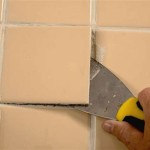How To Remove Grout Without Damaging Tile
Removing grout can be a necessary task for a variety of reasons, including repairing damaged grout, replacing cracked or discolored grout, or preparing for tile replacement. However, if not performed carefully, grout removal can easily result in damage to the surrounding tiles. A systematic approach combined with the right tools and techniques is crucial to ensure successful grout removal without causing costly tile repairs or replacements.
Before embarking on the grout removal process, it is essential to identify the type of grout present. Common grout types include sanded grout, unsanded grout, and epoxy grout. Sanded grout, suitable for wider grout lines, contains sand particles for added strength and reduced shrinkage. Unsanded grout, optimal for narrow grout lines, lacks sand and is less likely to scratch delicate tiles. Epoxy grout, known for its durability and stain resistance, is chemically resistant and typically more challenging to remove than cement-based grouts. Identifying the grout type will inform the selection of appropriate removal tools and techniques.
Proper preparation is paramount. This involves gathering the necessary tools and materials, protecting surrounding surfaces, and ensuring adequate ventilation. Essential tools may include a grout saw, a grout removal tool with a triangular blade, a rotary tool with a grout removal attachment, a utility knife, a shop vacuum, and safety glasses. A dust mask is also recommended to prevent inhalation of grout dust. To protect surrounding surfaces, drop cloths or plastic sheeting should be used to cover nearby countertops, cabinets, and flooring. Well-ventilated work areas are crucial to minimize exposure to dust and fumes.
The key to successful grout removal lies in patience and precision. Rushing the process or applying excessive force can easily lead to chipping, cracking, or scratching of the tiles. It is recommended to work in small sections and to take frequent breaks to avoid fatigue and maintain focus. Consistent, controlled movements are essential to achieve clean grout removal without damaging the adjacent tiles.
Choosing the Right Grout Removal Tool
The selection of the appropriate grout removal tool is crucial for achieving optimal results while minimizing the risk of tile damage. Several options are available, each with its own advantages and disadvantages. A manual grout saw is a cost-effective option for small to medium-sized projects. Its thin blade allows for precise cutting along the grout lines. However, manual grout saws require significant physical effort and can be time-consuming for larger areas. A grout removal tool with a triangular blade, often referred to as a corner grout saw, is particularly useful for removing grout from corners and tight spaces. The triangular blade design allows for effective grout removal without damaging adjacent surfaces.
A rotary tool equipped with a grout removal attachment offers a faster and more efficient option for larger projects. These attachments typically feature a diamond-coated or carbide-tipped cutting edge that quickly grinds away the grout. However, rotary tools require careful handling and precise control to prevent accidental contact with the tile surfaces. It is crucial to use a low speed setting and to maintain a steady hand to avoid overcutting or damaging the tiles. A utility knife can be used to score the grout lines before using other grout removal tools. This helps to create a clean, defined edge and can prevent chipping or cracking along the grout lines. However, utility knives should be used with extreme caution to avoid cutting oneself or damaging the tiles.
When choosing a grout removal tool, consider the size and complexity of the project, the type of grout being removed, and your level of experience. It is always recommended to practice on a small, inconspicuous area before tackling the entire project. This allows you to familiarize yourself with the tool and to refine your technique to minimize the risk of damage.
Techniques for Safe and Effective Grout Removal
Regardless of the chosen tool, employing proper techniques is imperative to ensure safe and effective grout removal. Start by scoring the grout lines with a utility knife to create a clean edge. This helps to prevent chipping and cracking of the tiles during the removal process. If using a manual grout saw or a grout removal tool with a triangular blade, hold the tool at a slight angle and apply gentle, consistent pressure. Avoid applying excessive force, as this can lead to tile damage. Work in small sections, overlapping each pass slightly to ensure complete grout removal. For wider grout lines, it may be necessary to make multiple passes to remove all of the grout.
If using a rotary tool with a grout removal attachment, start with a low speed setting and gradually increase the speed as needed. Maintain a firm grip on the tool and use smooth, controlled movements. Avoid pressing down too hard, as this can cause the tool to jump or skip, potentially damaging the tiles. Keep the tool moving constantly to prevent overheating and to ensure even grout removal. When working near corners or edges, exercise extra caution to avoid damaging adjacent surfaces. Consider using a smaller grout removal attachment or switching to a manual tool for these areas.
Throughout the grout removal process, regularly vacuum away the dust and debris to maintain a clear view of the work area. This also helps to prevent the grout dust from spreading to other areas of the home. After removing the bulk of the grout, use a small brush or a damp sponge to clean the grout lines and remove any remaining residue. Inspect the tiles for any signs of damage, such as chips, cracks, or scratches. If any damage is found, repair it promptly to prevent further deterioration.
Preventing Tile Damage During Grout Removal
Prevention is always preferable to repair. Several strategies can be implemented to minimize the risk of tile damage during grout removal. One of the most important is to use the right tool for the job. Choosing a tool that is appropriate for the type of grout being removed and the size of the grout lines can significantly reduce the risk of damage. Additionally, it is crucial to use the tool correctly. Read the manufacturer's instructions carefully and practice on a small, inconspicuous area before tackling the entire project.
Working slowly and carefully is crucial. Rushing the process or applying excessive force can easily lead to tile damage. Take your time and focus on making precise, controlled movements. Regularly inspect the tiles for any signs of damage and stop immediately if you notice any problems. Protecting the tiles with masking tape or painter's tape can also help to prevent scratches and chips. Apply the tape along the edges of the tiles, leaving only the grout lines exposed. This provides an extra layer of protection against accidental contact with the grout removal tool.
Controlling dust is another important aspect of preventing tile damage. Grout dust can be abrasive and can scratch the tiles if it is allowed to accumulate on the surface. Regularly vacuum away the dust as you work and consider using a wet saw to minimize dust generation. If you are using a wet saw, be sure to clean the tiles thoroughly after each pass to remove any remaining slurry. Finally, remember to wear safety glasses and a dust mask to protect yourself from injury and to prevent inhalation of grout dust.
Following these preventative measures, along with the proper techniques mentioned above, significantly reduces the chances of damaging tiles during grout removal, helping to ensure a successful and aesthetically pleasing renovation.

How To Remove And Replace Grout In A Shower Diy For Beginners

How To Remove Grout 8 Steps With Pictures Wikihow

How To Remove Grout From Tile Rubi Blog Usa

How To Clean Grout Tips For Natural Stone Flooring Granite Gold
How To Remove Grout Replacing Stonesuper

Easiest Way To Clean Grout Without Scrubbing Microfiber Whole

How To Remove Tiles From The Wall Using A Multi Tool Carefully Without Damage

How To Clean Grout Tile Cleaning Tips Simply Spotless
How To Remove Grout From Tiles Bunnings New Zealand

How To Remove A Tile Floor Complete Step By Guide Apollo
Related Posts








